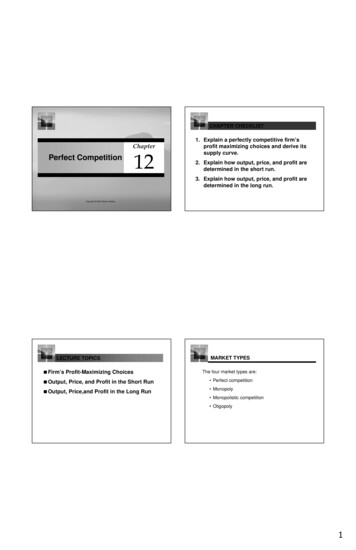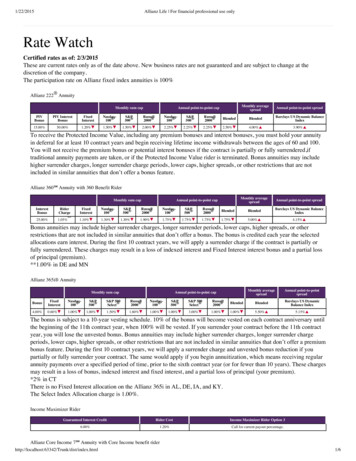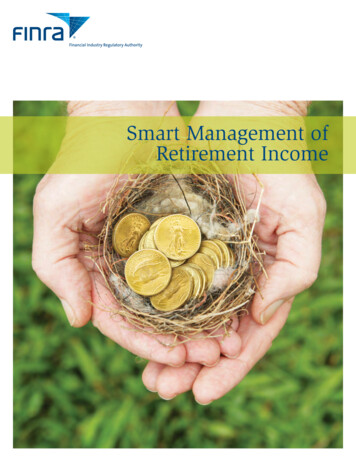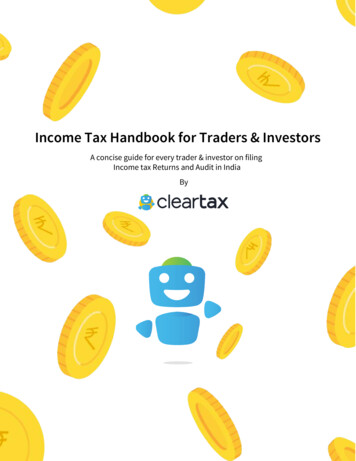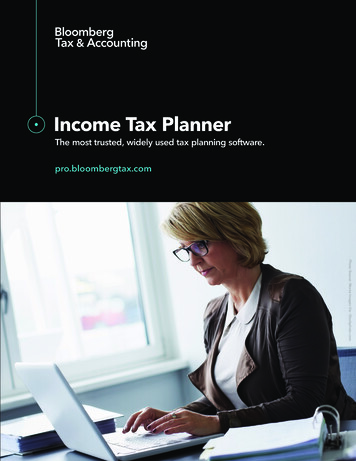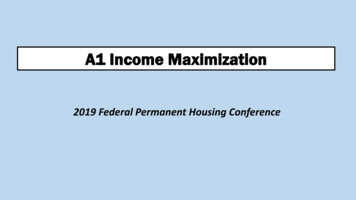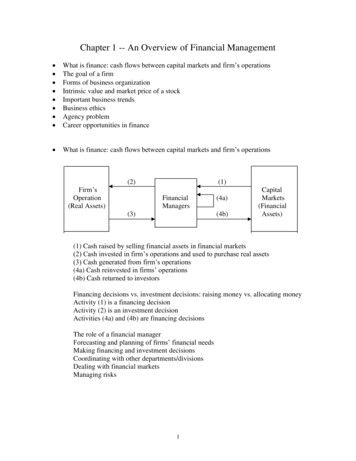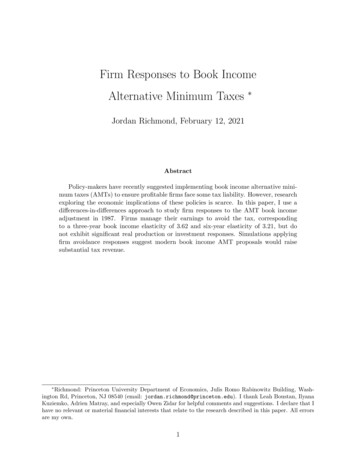
Transcription
Firm Responses to Book IncomeAlternative Minimum Taxes Jordan Richmond, February 12, 2021AbstractPolicy-makers have recently suggested implementing book income alternative minimum taxes (AMTs) to ensure profitable firms face some tax liability. However, researchexploring the economic implications of these policies is scarce. In this paper, I use adifferences-in-differences approach to study firm responses to the AMT book incomeadjustment in 1987. Firms manage their earnings to avoid the tax, correspondingto a three-year book income elasticity of 3.62 and six-year elasticity of 3.21, but donot exhibit significant real production or investment responses. Simulations applyingfirm avoidance responses suggest modern book income AMT proposals would raisesubstantial tax revenue. Richmond: Princeton University Department of Economics, Julis Romo Rabinowitz Building, Washington Rd, Princeton, NJ 08540 (email: jordan.richmond@princeton.edu). I thank Leah Boustan, IlyanaKuziemko, Adrien Matray, and especially Owen Zidar for helpful comments and suggestions. I declare that Ihave no relevant or material financial interests that relate to the research described in this paper. All errorsare my own.1
“You cannot go to a mill where somebody is making 20,000 a year and attempt toexplain to them why a major American corporation can have over 1 billion in profitsand pay no taxes.” – Senator Bob Packwood on alternative minimum taxes1In 2017, Amazon reported 5.6 billion in profit but paid 0 in taxes (Gardner, 2020).Profitable firms like Amazon with very small tax bills often face public ire, and their existence undermines public perceptions of a fair tax code. Over the last forty years in theUnited States, tax policymakers have attempted to eliminate the divergence of some firms’incomes and tax liabilities by imposing alternative minimum taxes (AMTs). Profitable firmscan owe small tax bills because the tax code includes deductions and credits meant to incentivize productive economic behavior, but substantial use of these incentives can eliminateall tax liabilities. AMTs assign a lower tax rate to a broader tax base that excludes manydeductions and credits, implicitly limiting economic incentives in an effort to raise revenuefrom profitable firms and bolster public perceptions of tax code fairness.In both the United States and OECD talks, recent tax proposals have included an AMTbased on book income, the income firms report on their financial statements. These proposalsmay be appealing because book income provides a broad tax base, suggesting a book incomeAMT could effectively raise revenue from profitable firms that pay few taxes. However, abook income AMT’s capacity to raise revenue may be limited by tax avoidance becausefirms have substantial discretion to determine their own book incomes (Manzon and Plesko,2002), while broadening the tax base could lead firms to make inefficient changes to theirproduction and investment policies.In this paper, I estimate firm responses to a book income AMT by exploiting variationin the minimum tax rate on book income introduced by the alternative minimum tax bookincome adjustment (AMTBIA87) in 1987. AMTBIA87 is the only U.S. AMT that has everincorporated book income into the tax base. I use a differences-in-differences empirical strategy that compares firms more likely to be subject to the AMT on book income (treatment)to firms less likely to face the tax (control), dividing firms into treatment and control groupsbased on their effective tax rates in 1986. This empirical approach identifies firm responsesoff the difference in the evolution of outcomes for firms that are more or less likely to facethe book income AMT, assuming that their outcomes would have evolved similarly in the1U.S. Senate Finance Committee Hearing. May 3, 1995. “Alternative Minimum Tax”.2
absence of the policy.Using Compustat data, I find strong evidence that firms manage their earnings to avoidAMTBIA87. My preferred point estimates suggest that over a three-year time horizon theelasticity of book income with respect to the net of tax rate is 3.62, while over a six-yeartime horizon the elasticity of book income is 3.21. I measure firms’ earnings managementresponses using book tax differences, which reflect discretionary changes firms can maketo their book incomes while holding fixed investment and production responses. Theseavoidance elasticities are roughly ten times larger than estimates of the elasticity of corporatetaxable income in the U.S. and U.K. (Gruber and Rauh, 2007; Devereux, Liu and Loretz,2014), reinforcing that they are unlikely to reflect real economic responses to AMTBIA87.Robustness checks indicate that my estimates of tax avoidance are unlikely to be drivenby mean reversion or simultaneous tax policy changes included in the Tax Reform Act of1986 (TRA86). Placebo differences-in-differences series that split firms into treatment andcontrol groups based on effective tax rates in earlier tax years exhibit book tax differencespikes in the year of the split that revert to 1985 levels in the subsequent year, suggestingmean reversion is unlikely to drive the results. Meanwhile, TRA86 included concurrent taxpolicy changes that reduced the corporate rate and increased the cost of capital - reformsthat a priori might have differential impacts across firms in the treatment and control groupsbased on different industry, firm size and effective tax rate compositions. However, variousdifferences-in-differences specifications that flexibly control for these firm characteristics allyield similar estimates of tax avoidance.This paper adds to a substantial literature that uses financial statement or tax datato estimate earnings management responses to AMTBIA87 (Gramlich, 1991; Dhaliwal andWang, 1992; Boynton, Dobbins and Plesko, 1992; Manzon, 1992; Wang, 1994; Choi, Gramlichand Thomas, 2001). AMTBIA87 was announced in 1986 but not implemented until 1987,creating an opportunity for firms to shift book income out of the period the tax was ineffect and into 1986. Therefore, earlier work focused on measuring strategic shifting of bookincome out of 1987 and into 1986 to avoid the tax altogether, and book income decreases in1987 to reduce tax liability. While the earlier literature established a consensus that firmsdecreased their book incomes in 1987, substantial debate persisted over the presence and3
magnitude of book income increases in 1986.This paper builds on the earlier AMTBIA87 literature in four ways. First, I show thatprevious studies underestimate book income elasticities by not accounting for pre-trends.Second, I estimate firm responses over a longer time frame from 1986-1992, finding thatavoidance responses stabilize over a four- to six-year time horizon. Third, I show that anyperceived book income shifting into 1986 can be attributed to selection in the treatment definition rather than tax avoidance. Finally, I explore heterogeneity across firm sizes, industries,and tax exposure intensities to shed light on mechanisms underlying firm responses.Additional differences-in-differences estimates show that firms are unlikely to respond toa book income AMT by modifying their production or investment policies. Using revenues,costs of inputs, investment and debt as outcomes, I fail to reject the null hypothesis of zeroresponse to AMTBIA87 in any year from 1987-1992 for all four outcomes. Complementaryinstrumental variables analysis suggests that increases in total tax liability stemming fromAMTBIA87 increase tax revenues, but have no detectable impact on firm revenue, costs ofinputs, investment or debt.The estimates of tax avoidance and lack of evidence for investment and productionchanges in this paper are consistent with economic models of firm responses to taxationsuggesting that, if possible, firms will evade or avoid taxes before making real economicchanges. Existing research on minimum tax schemes in Pakistan, Hungary, Guatemala andHonduras emphasizes that firms evade minimum taxes by overreporting costs rather thanby making changes to production or investment (Best, Brockmeyer, Kleven, Spinnewijn andWaseem, 2015; Mosberger, 2016; Alejos, 2018; Lobel, Scot and Zuniga, 2020). In CostaRica, firms over-report costs to escape higher tax rates, and in Spain, firms under-reportrevenues to escape increased government scrutiny (Bachas and Soto, Forthcoming; Almuniaand Lopez-Rodriguez, 2018). While the U.S. is generally thought to have higher tax enforcement capacity than these other countries, flexible accounting standards allow firms to avoidAMTBIA87 just as they might evade a minimum tax in a lower-enforcement environment.In light of firm responses to AMTBIA87, contemporary proposals to implement a bookincome AMT will accomplish their goals if they successfully raise revenue from profitablefirms with low tax bills despite firms’ tax avoidance responses. To evaluate the implications4
of the earnings management that I estimate in response to AMTBIA87 for contemporarypolicies, I develop a ten-year revenue score for the book income AMT included in Joe Biden’s2020 tax plan. My revenue scoring methodology simulates the evolution of book incomes overthe scoring time frame, incorporating estimates of firm tax avoidance into the simulation.In my preferred revenue score that directly applies point estimates of avoidance responsesto AMTBIA87, I estimate that the proposed Biden book income AMT would raise 286billion over a decade. Roughly three-quarters of the tax revenue comes from utilities, finance,manufacturing and transportation firms, and close to one-third of the revenue comes fromthe ten firms facing the largest tax liability increases. Hewlett Packard, Berkshire HathawayEnergy and Delta Air Lines are among the firms facing the largest tax liability increases.However, Amazon only faces the 22nd largest tax liability increase because foreign tax creditsand net operating losses reduce their book income AMT liability. These results suggestthat, even after accounting for tax avoidance, a book income AMT could raise revenue fromprofitable firms, but that the specific design of any book income AMT may leave leeway forprofitable firms like Amazon to mitigate increases in tax liability.By varying elasticity assumptions in revenue simulations, I also show that revenue scoresof the proposed Biden book income AMT by third parties are often inconsistent with theavoidance responses I estimate to AMTBIA87. For example, to match the Biden campaign’srevenue estimate, I need to assume close to zero avoidance responses to the policy, whileto match the American Enterprise Institute estimate, I need to assume avoidance responsesmore than four times as large as firm responses to AMTBIA87.The rest of the paper is organized as follows. Section I describes tax policy details.Section II describes the data and section III describes the empirical strategy. Sections IVand V estimate firm tax avoidance and production and investment responses to AMTBIA87.Section VI incorporates estimates of firm tax avoidance into revenue scores of the proposedBiden book income AMT. Section VII concludes.5
ITax Policy DetailsAlternative minimum tax liability in the U.S. is calculated as the excess of potential AMTliability over normal tax payments. Potential AMT liability is the AMT rate applied to abroad income base called alternative minimum taxable income (AMTI), defined as taxableincome (TI) plus tax preferences and adjustments (TPA) that add deductions and creditsback to taxable income. TRA86 set the AMT rate at 20%, and introduced AMTBIA87,which broadened the AMT base with a book income adjustment (BIA) by adding 50% ofthe difference between AM T I and book income (BI) to the tax base. In equations,(1) BIA 0.5 BI (T I T P A) ,n oAM T max 0.2 T I T P A BIA τ T I, 0 .In short, AMTBIA87 imposed a 10% marginal tax rate on book income in excess of AM T Ifor any firms subject to the AMT.Congress voted to adopt TRA86 in 1986, so that firms were aware of AMTBIA87 whilefiling their 1986 financial statements. AMTBIA87 went into effect the next year, in 1987.This window provided an opportunity for firms to respond to AMTBIA87 through advancedaccounting planning before the policy went into effect.During the legislative debate over TRA86 Congress considered multiple AMT reforms.Congress was unsure whether they should implement AMTBIA87, or the adjusted currentearnings adjustment (ACEA90), which aimed to construct a measure of income as broad asbook income using tax principles (Redmond Soneff, 1986). In the final version of TRA86,Congress chose to implement AMTBIA87 from 1987-1989 and replace it with ACEA90 in1990, but also commissioned a Treasury study due before the 1990 switch to explore theimpacts of both AMT policies (Redmond Soneff, 1986). While this congressional hedginglikely caused some uncertainty about whether AMTBIA87 would be replaced with ACEA90,the policy switch occurred in 1990 as originally specified.ACEA90 imposed a 20% tax on three-quarters of the difference between a corporation’s6
adjusted current earnings (ACE) and their AM T I. In equations, ACEA 0.75 ACE (T I T P A) , AM T max{0.2 T I T P A ACEA τ T I, 0}.(2)ACE attempted to construct a measure of income as broad as book income using tax principles by eliminating deductions that restricted the breadth of AM T I and broadening theAM T I base (Janiga, 1988).2 Finally, both AMTBIA87 and ACEA90 generated minimumtax credits that could be used to reduce normal tax liability down to minimum tax liabilityin future years where firms did not pay the AMT.3Figure 1: Marginal Tax Rates on Book Tax DifferencesNotes: This figure presents the evolution of marginal tax rates on book tax differences due to thealternative minimum tax book income adjustment (AMTBIA87) and the adjusted current earningsadjustment (ACEA90). Tax rates assume proper controls for tax preferences and adjustments, andafter 1990 assume adjusted current earnings (ACE) are equivalent to book income.2For example, ACE includes depreciation that is allowed as a deduction for AM T I purposes. ACE alsoincludes forms of income excluded from AM T I like interest on tax-exempt bonds and income on annuitycontracts. Janiga (1988) provides additional details.3AMT credits have historically been awarded for deferral items that cause temporary differences betweenAMTI and taxable income over time like depreciation, but not exclusion items that cause permanent differences over time like exclusions for small business stock gains. These credits therefore reduce tax burdensover the long-run particularly in capital intensive industries.7
After controlling for T P A and assuming ACE is equivalent to book income, both AMTBIA87 and ACEA90 imposed marginal taxes on book tax differences. I summarize variationin the marginal tax rate on book tax differences over time in Figure 1. There was no tax onbook tax differences before 1987. From 1987-1989 AMTBIA87 imposed a 10% marginal taxrate on book tax differences. Starting in 1990, the replacement of AMTBIA87 with ACEA90increased the marginal tax rate on book tax differences to 15%.IIDataTo evaluate how firms respond to AMTBIA87, I construct a balanced panel of large, persistent Compustat firms that were the target of AMTBIA87, and are also likely to be thetype of firms targeted by any contemporary book income AMTs. To construct this panel, Irestrict to firms that appear in every year from 1981-1992 with positive, non-missing assets,sales and pretax income that are incorporated in the U.S. and have 1986 EBITD over 100million.4 I end the panel in 1992 because the Omnibus Budget Reconciliation Act of 1993changed the ACEA90 tax base.5Table 1 provides summary statistics for a 1985 cross section of my sample, with allvariables rescaled into 2018 dollars.6 Means far exceed medians for most variables across thewhole sample, reflecting the skewed firm size distribution. The sample only includes 8% ofall firms in Compustat in 1985, but these firms hold 32% of all assets and take in 33% of allrevenues. While these firms are not representitive of the economy as a whole, they reflectthe set of firms targeted by AMTs.They key variable I use to categorize firms into treatment and control groups is the effective tax rate, because firms with lower effective tax rates are more likely to face AMTBIA87.I measure effective tax rates as tax liability divided by book income, following Collins andShackleford (2004) to define tax liability as total income taxes minus deferred income taxes4I calculate earnings before interest, taxes, and depreciation as income before extraordinary items plusextraordinary items and discontinued operations plus interest expense plus taxes plus depreciation andamortization.5OBRA eliminated the adjusted current earnings depreciation adjustment for property placed in serviceafter 1993, effectively narrowing ACE by allowing depreciation deductions.6I inflate to 2018 dollars using the GDP price deflator from NIPA table 1.1.9, “Implicit Price Deflatorsfor Gross Domestic Product” from the BEA.8
Table 1: Summary Statistics for 1985 Cross Section of Estimation SampleAssetsBook IncomeTaxable IncomeBook Tax DifferencesSalesCosts of Goods SoldInvestmentDebtDepreciationDepletionInterest 740.230.2923752215335697717 s: This table reports summary statistics for a 1985 cross section from the sample of firms used to estimate firm responses to the alternative minimum tax bookincome adjustment. Statistics are in millions of USD, expect for counts, thousandsof employees, investment (capital expenditure per dollar of lagged net property plantand equipment) and debt (total liabilities per dollar of total assets).minus other taxes.The key outcomes to measure firm tax avoidance, production, and investment responsesare book tax differences, sales, costs of goods sold, investment, and debt. Book tax differences, defined as the difference between book income and taxable income, is a commonmeasure of earnings management and tax sheltering that captures discretionary changesfirms make to their book incomes rather than production or investment responses (Hanlon,2005; Wilson, 2009).7 By construction, this variable captures the portions of book incomenot included in taxable income, explicitly excluding firm taxable income changes that couldarise in response to changes in the corporate tax rate.8 I define investment as capital expenditure per dollar of lagged net property plant and equipment (Cummins, Hasset andHubbard, 1994; Desai and Goolsbee, 2004; Edgerton, 2010; Ohrn, 2018) and debt as total7Following Collins and Shackleford (2004) I define taxable income as total tax liability divided by themarginal tax rate.8A few important differences between book and taxable income are that book income includes allmajority-owned foreign and domestic subsidiaries while taxable income does not, and that firms have significantly more discretion to modify book income than taxable income because generally accepted accountingprinciples that define book income give managers discretion to choose different methods of income measurement.9
liabilities per dollar of lagged assets (Edgerton, 2010; Ohrn, 2018). A substantial fractionof finance firms in the sample are missing information required to construct the investmentvariable. I also winsorize all outcome variables at the 1st and 99th percentile.IIIEmpirical StrategyAMTBIA87 was more likely to apply to firms with lower effective tax rates that reportfewer taxes paid on their financial statements. Building on previous analyses of AMTBIA87(Dhaliwal and Wang, 1992), I assess firm responses to the policy by comparing two groups offirms, a treatment and control group, that are more and less likely to be subject to the AMTbased on their effective tax rate (ETR).9 I compare firms with ETRs 23% (treatment)to firms with ETRs 23% (control) in 1986. The 23% ETR cutoff represents the ETR atwhich firms are likely to no longer have to pay alternative minimum tax. I discuss the detailsof this calculation in Appendix A. To execute the comparison between my treatment andcontrol groups, I estimateYit (3)1992X βτ · T reatiτ β1 Xit β2 T reati · Xit δt γi εit ,τ 1981,τ 6 1985where T reati is an indicator equal to 1 if ETR 23% in 1986 and 0 if ETR 23% in 1986.T reatiτ is the interaction of T reati and a year indicator (year τ ), Xit are time varyingfirm-level covariates, δt are year fixed effects, and γi are firm fixed effects.I can interpret the βτ coefficients in equation (3) as the causal impacts of AMTBIA87on outcome variables under the assumption that the outcome variables in the treatment andcontrol group would have evolved similarly in the absence of the policy. However, I also relaxthis assumption to allow for linear pre-trends10 by estimatingYit α · T reati · t (4)1992X βτ · T reatiτ β1 Xit β2 T reati · Xit δt γi εit .τ 1986In equation (4), the βτ coefficients can be interpreted as the causal effect of AMTBIA87 on910I measure effective tax rates as tax liability divided by book income in each year.For another example of this approach, see Dobkin, Finklestein, Kluender and Notowidigdo (2018).10
firm outcomes under the assumption that any linear outcome trend for treatment relative tocontrol firms in the pre-period would have continued in the absence of AMTBIA87.Equations (3) and (4) estimate firm responses to AMTBIA87 using a binary treatmentapproach, identifying the average treatment effect of the policy before and after allowing forlinear pre-trends. However, firms subject to AMTBIA87 faced different levels of tax liabilityincreases, and therefore may be subject to different treatment intensities. To account for thepossibility that firms respond to AMTBIA87 heterogeneously depending on the level of taxliability increase they face, I also estimate(5)1992XYit βτ · Liabiτ β1 Xit β2 Liabi · Xit δt γi εit ,τ 1981,τ 6 1985(6)Yit α · Liabi · t 1992X βτ · Liabiτ β1 Xit β2 Liabi · Xit δt γi εit ,τ 1986where Liabi is the interaction of an indicator for the treatment group and 10% of 1986 booktax differences, and Liabiτ is the interaction of Liabi and a year indicator. Equation (5)parametrically controls for treatment intensity, and equation (6) modifies (5) to allow forlinear pre-trends.IVTax Avoidance ResponsesI use book tax differences as the outcome Yit in equations (3) - (6) to measure tax avoidanceresponses to AMTBIA87 for two reasons. First, book tax differences capture discretionarychanges firms can make to their book incomes, holding fixed production and investmentbehavior captured by taxable income by measuring the portion of book income that is bydefinition not part of taxable income. Second, as displayed in equation (1), AMTBIA87levied a tax on BT D T P A. TPA account for an average of 39% of book tax differencesacross 1987-1989, but 88% of these TPA can be attributed to depreciation and depletion(Gill and Treubert, 1992). Therefore, after controlling for depreciation and depletion, usingbook tax differences as an outcome focuses estimation directly on the portion of income11
taxed by AMTBIA87 without capturing taxable income responses.11To portray the raw data over time, Figure 2, panel (a) plots the progression of book taxdifference means by year for treatment and control firms. Three important points arise frompanel (a). First, book tax differences appear to increase for treatment relative to control firmsin the pre-period. Second, treatment firms exhibit a sharp increase in book tax differencesin 1986, providing suggestive evidence that firms responded to AMTBIA87 by shifting bookincome into 1986. Finally, book tax differences decline for treatment firms relative to controlfirms in the periods while AMTBIA87 and ACEA90 are in effect.Formalizing the comparison of raw means in Figure 2, panel (a), I plot the βτ coefficientsfrom equation (3) bracketed by their 95% confidence intervals in the baseline series of Figure2, panel (b). Standard errors are clustered at the firm level. I include firm assets, sales,interest expense, depreciation, depletion and number of employees in Xit to control forchanges in firm size, the possibility that tax incentives differentially impact firms with lowversus high ETRs, and the vast majority of tax preferences and adjustments to isolatevariation in the outcome independent of non-AMTBIA87 tax incentives.The baseline series in panel (b) exhibits clear pre-trends, suggesting that estimates ofequation (3) are likely to understate firm tax avoidance in response to AMTBIA87. Guidedby the data, I also estimate equation (4) and plot the βτ coefficients in the pre-trend adjustment series of panel (b). The pre-trend adjustment series displays two important results.First, there appears to be a clear increase in book tax differences in 1986 for firms more likelyto be subject to AMTBIA87 the next year, suggesting firms more likely to face AMTBIA87strategically concentrated book income independent of taxable income into 1986 before bookincome was subject to a tax. Second, firms more likely to be subject to AMTBIA87 exhibita clear decline in book tax differences relative to the 1986 spike throughout 1987-1992, suggesting firms more likely to face AMTBIA87 reduced their book tax differences relative tocontrol firms while AMTBIA87 and ACEA90 were in effect.11With administrative tax data, I could simply subtract T P A from the outcome. However, depreciationand depletion in Compustat do not exactly measure the depreciation and depletion components of T P A. Forexample, T P A includes depreciation of property placed in service after 1986, not all depreciation. Therefore,controlling for variation in Compustat depreciation over time captures changes to depreciation included inT P A without introducing substantial measurement error in the outcome based on previous depreciationlevels which are likely to covary with treatment status.12
(a) Raw Book Tax Difference Means(b) Baseline SpecificationFigure 2: Differences-in-Differences EstimatesNotes: This figure presents the evolution of mean book tax differences for treatment and controlfirms in panel (a), and baseline differences-in-differences estimates from equations (3) and (4) inpanel (b). 95% confidence intervals are constructed from standard errors clustered at the firm level.The vertical gray dashed line indicates the time frame when firms were aware AMTBIA87 wouldgo into effect the following year, while red lines demarcate the time period when AMTBIA87 wasin effect. The treatment group is defined as firms with 1986 effective tax rates 23%.IV.ATax Avoidance RobustnessTwo primary confounders could bias the estimates of βτ plotted in Figure 2, panel (b). First,if book tax differences exhibit mean reversion and covary with ETRs, systematic year-to-yearchanges in book tax differences could correlate with the expected impacts of AMTBIA87.Second, other policies in TRA86 could introduce non-AMTBIA87 related changes in booktax differences around the implementation of AMTBIA87 that covary with ETRs.12To evaluate whether mean reversion impacts the estimates in Figure 2, panel (b), I plotplacebo differences-in-differences (DiD) estimates alongside my baseline results in Figure 3,panel (a). The placebo series exactly replicate the baseline estimates of equation (3) inFigure 2, panel (b), but define treatment and control groups based on ETRs in 1982, 1983,1984 and 1985 rather than 1986. These placebo series make two important points. First,placebos exhibit book tax difference declines similar to the baseline series, but the declines12These potential confounders are identical to the two mentioned by Saez, Slemrod and Giertz (2012) intheir review of the elasticity of taxable income literature. They are a common feature (or bug) of empiricaldesigns attempting to evaluate the impact of a tax change while constructing treatment and control groupsbased on pre-reform information.13
diminish in magnitude for the earlier treatment control splits. This pattern is consistent withthe estimated treatment effects representing firm responses to AMTBIA87, where splittinginto treatment and control firms in earlier years captures fewer firms likely to be subject toAMTBIA87.Second, despite no policy incentive to do so, treatment firms exhibit a spike in book taxdifferences in the year I split firms into treatment and control groups based on ETRs thatdiminishes in the following year or two. Therefore, selection of high book tax difference firmsfor the treatment group appears to bias β86 upward, while mean reversion does not appearto have a significant impact on my estimates because book tax differences largely revert inthe year after the treatment designation.The finding that a significant portion of the 1986 book tax difference spike can be attributed to selection rather than a real avoidance response clarifies the lack of consensusover firm responses in 1986 in the existing literature.13 The placebo series in Figure 3, panel(a) make clear that this disagreement stems from different treatment and control definitionsacross studies, not real avoidance responses. To formally test that the observed 1986 spikeis not a real avoidance response I stack the 1982-1985 placebo series and estimate an eventstudy defining event-time zero to be the year I split each placebo series into treatment andcontrol groups. The event-time zero coefficient in this specification aggregates observed booktax difference spikes in the year I split into treatment and control groups, effectively averaging over the spikes in each placebo series. A Wald test for the equality of the event
the book income AMT, assuming that their outcomes would have evolved similarly in the 1U.S. Senate Finance Committee Hearing. May 3, 1995. \Alternative Minimum Tax". . 1986 (TRA86). Placebo di erences-in-di erences series that split rms into treatment and control groups based on e ective tax rates in earlier tax years exhibit book tax di erence



